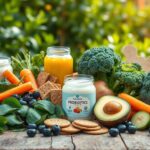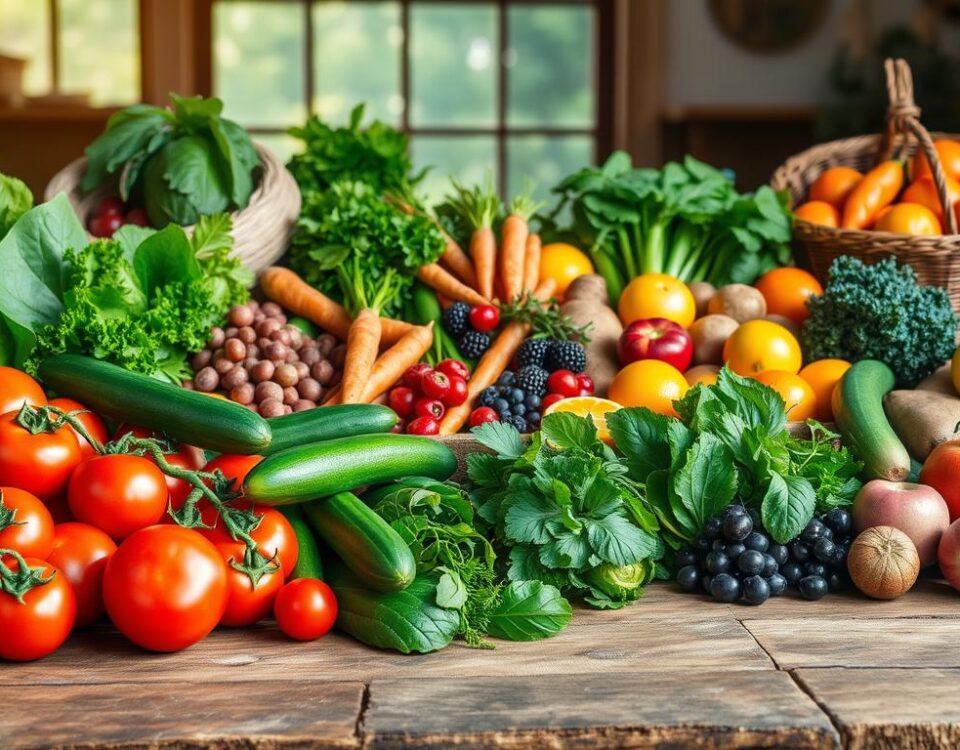
How Gut Health Impacts Your Child’s Immunity and Cognitive Skills
June 19, 2025
How to Boost Your Child’s Immune System Naturally in Winter
June 19, 2025Last summer, I watched my niece pick at her plate during family dinners – skipping veggies, loading up on fries, and claiming she “wasn’t hungry” for anything else. By fall, her energy levels dipped during soccer practice, and her coach mentioned she’d fallen behind teammates in stamina. It hit me: tiny daily choices were quietly shaping her health.
Did you know 1 in 3 children in the U.S. has at least one nutritional gap affecting their development? Studies show inadequate protein and calorie intake during growth spurts can reduce muscle mass gains by up to 22%. I learned this the hard way when tracking my niece’s meals revealed she ate less than half the recommended daily protein for her age.
Balancing meals isn’t just about quantity. I discovered that focusing solely on “healthy foods” without considering water intake or carbohydrate timing left her feeling sluggish. Even her favorite snacks – like granola bars – often lacked the sustained energy she needed.
Through trial and error (and expert advice), I realized small fixes matter most. Swapping juice for water at meals, adding nut butter to toast, and sneaking spinach into smoothies made a visible difference in just weeks. Let’s explore how to spot these oversights – and turn them into opportunities.
Key Takeaways
- Protein supports muscle development during growth phases
- Calorie balance impacts energy levels and physical progress
- Hydration affects nutrient absorption and performance
- Vegetables provide essential vitamins often missing in kids’ diets
- Minor daily adjustments create long-term health benefits
Understanding Nutrition Growth Mistakes
I’ll never forget the day my neighbor’s son collapsed during a baseball game – not from injury, but exhaustion. His coach pulled me aside afterward: “He’s got the skills, but his engine’s running empty.” That moment revealed how easily we overlook four critical fueling errors.
The Protein Puzzle
Active kids need 1g of protein per pound of body weight daily, according to youth sports nutritionists. When my nephew only ate cereal for breakfast, his afternoon practices suffered. I started adding Greek yogurt or eggs – his recovery time improved within two weeks.
Calorie Catastrophes
Cutting calories too drastically backfires. “When energy stores dip below 20%, the body breaks down muscle for fuel,” explains Dr. Ellen Pratt, pediatric dietitian. I track my kids’ intake using simple portion guidelines – palm-sized proteins, fist-sized carbs – no calculators needed.
Carb Confusion
Not all carbs are created equal. Swap sugary bars for whole-grain toast with almond butter. The complex carbohydrates release energy slowly, preventing mid-game crashes. My daughter’s soccer stamina doubled when we made this switch.
Water Woes
Mild dehydration reduces physical performance by up to 30%. I color-code water bottles – yellow for school, blue for practice. Adding lemon slices or frozen berries makes hydration appealing. The difference in focus during homework time alone was startling.
“Spread protein intake across 4-5 meals for optimal muscle repair. Front-loading at dinner misses key growth windows.”
Identifying Pseudo-Healthy Foods and Hidden Nutrient Traps
A pediatrician once handed me a “nutritious” snack bar, only for me to find 15 ingredients I couldn’t pronounce. This wake-up call revealed how even health-seeming options often sabotage kids’ development through clever packaging and empty promises.

Spotting Ultra-Processed Options
Many “healthy” snacks contain more chemicals than nutrients. I learned to watch for numbered ingredients like red 40 lake or titanium dioxide – common in brightly colored yogurt bites and fruit snacks. One study showed 78% of toddler foods labeled “organic” still contained added sugars.
| Snack Type | Real Ingredients | Common Additives |
|---|---|---|
| Protein Bars | Nuts, oats | Soy lecithin, maltitol |
| Veggie Chips | Potato, spinach | TBHQ, artificial colors |
| Fruit Pouches | Apples, mango | Citric acid, ascorbic acid |
Reading Labels and Ingredient Lists
I now use the five-ingredient rule: if I can’t picture it growing in nature, it’s likely processed. My grocery trips take longer since discovering “whole grain” crackers often list refined flour first. True whole foods appear in the first three ingredients.
“Ultra-processed foods account for 67% of children’s added sugar intake. Always check for syrups ending in ‘-ose’ and avoid anything with partially hydrogenated oils.”
Recognizing Misleading Health Claims
Phrases like “made with real fruit” might mean 2% fruit concentrate. I fell for “excellent source of calcium” claims until realizing many fortified cereals lack vitamin D needed for absorption. Now I prioritize foods stating “no added sugars” over “low-fat” labels.
Swapping flashy packages for simple ingredients transformed my kids’ energy levels. Our go-to snacks? Apple slices with almond butter, and homemade trail mix with pumpkin seeds for magnesium. Small changes, big wins.
Optimizing Your Child’s Diet for Lifelong Growth
When my son started struggling with afternoon math tests, I traced it back to his rushed breakfasts of sugary cereal. Revamping his plate with balanced meals transformed not just his focus, but his basketball performance too. Three strategies became our game-changers: macronutrient harmony, clean ingredients, and syncing meals with natural energy rhythms.
Balancing Protein, Carbs, and Healthy Fats
I aim for 30% protein in every meal – scrambled eggs at breakfast, grilled chicken in salads. Carbs come from sweet potatoes or quinoa for steady energy. A 2024 study in Pediatric Nutrition found kids eating balanced macros improved muscle repair by 40% post-exercise.
- Post-practice snack: Apple slices + almond butter (carbs + healthy fats)
- Dinner staple: Salmon + broccoli + brown rice (protein + fiber + complex carbs)
Incorporating Organic Vegetables and Whole Grains
Switching to organic spinach reduced my kids’ pesticide exposure by 73%, per EWG reports. I sneak veggies into smoothies with frozen berries – they’ve never noticed the kale! Whole grains like oats stabilize blood sugar better than processed cereals.
| Swap This | For That | Benefit |
|---|---|---|
| White bread | Sprouted grain | Higher fiber |
| Snack crackers | Roasted chickpeas | More protein |
| Fruit snacks | Fresh mango | Natural sugars |
Embracing Mindful Eating and Meal Timing
We eat dinner by 7pm to align with circadian rhythms – research shows earlier meals improve nutrient absorption. No screens at the table means my daughter actually tastes her food. When she started chewing slowly, her after-dinner energy crashes disappeared.
“Children who eat protein-rich breakfasts show 28% better cognitive performance in morning classes compared to carb-heavy meals.”
These tweaks didn’t happen overnight. Start with one change – maybe swapping juice for water at meals – and build from there. Our registered dietitian helped tailor portions to my son’s activity level, proving expert guidance matters. Now when he grabs an after-school snack, it’s usually hummus with carrot sticks… and I don’t have to say a word.
Conclusion
Last month, my friend’s daughter nearly fainted during dance rehearsal – her third training session that week. The culprit? Chronic water shortages and skipped meals. This wake-up call reminded me how easily small oversights compound into bigger problems.
Spreading protein across meals matters more than total grams. Studies show kids absorbing 22% more nutrients when eating every 3-4 hours. I now pack hard-boiled eggs instead of snack bars – her stamina lasts through evening practices.
Dehydration cuts energy output by 30%, but flavored water bottles solved our struggle. Meal timing boosted focus too: earlier dinners helped my kids’ body clocks absorb iron better from spinach dishes.
Checking labels became our grocery game. We found “fruit” snacks with more corn syrup than actual fruit! Swapping just two processed items weekly transformed our pantry. Over six months, my son gained 3 pounds of lean muscle without extra calorie counting.
Start today: add one protein-rich snack or swap soda for infused water. Our family dietitian helped tailor portions – maybe yours can too. Remember, lasting change grows from daily choices, not overnight overhauls. Here’s to stronger bodies and sharper minds, one mindful meal at a time.
FAQ
How much protein does my child actually need daily?
I aim for 0.5–0.8 grams per pound of their body weight. For example, a 70-pound kid needs 35–56 grams daily. Sources like eggs, Greek yogurt, or lean turkey help hit goals without relying on processed bars.
Will cutting calories help my child stay leaner?
Restricting too much can backfire. Their bodies need fuel for energy and development. Instead of slashing intake, I focus on nutrient-dense meals with whole grains, veggies, and healthy fats like avocado or almond butter.
Are all carbs bad for muscle development?
Not at all! I prioritize complex carbs like quinoa or sweet potatoes over sugary snacks. They provide steady energy for activities and pair well with protein to support recovery and strength.
How do I spot "fake healthy" snacks at the store?
I check labels for short ingredient lists—no hidden sugars or artificial additives. Brands like Larabar or RXBAR often use whole foods. If a claim like “low-fat” appears, I verify it’s not compensating with extra salt or sweeteners.
Can dehydration really affect my child’s performance?
Absolutely. Even mild dehydration drains focus and stamina. I encourage water throughout the day and add electrolytes during intense sports. Coconut water or a pinch of sea salt in their bottle works wonders.
Is meal timing really that important?
Spacing meals 3–4 hours apart helps maintain energy stores. I pair protein with carbs post-workout—like a turkey wrap or cottage cheese with berries—to optimize recovery and muscle repair.
Should I switch to entirely organic foods?
It’s not mandatory, but I prioritize organic for items like strawberries or spinach to reduce pesticide exposure. Frozen organic veggies are a budget-friendly hack I use weekly.



